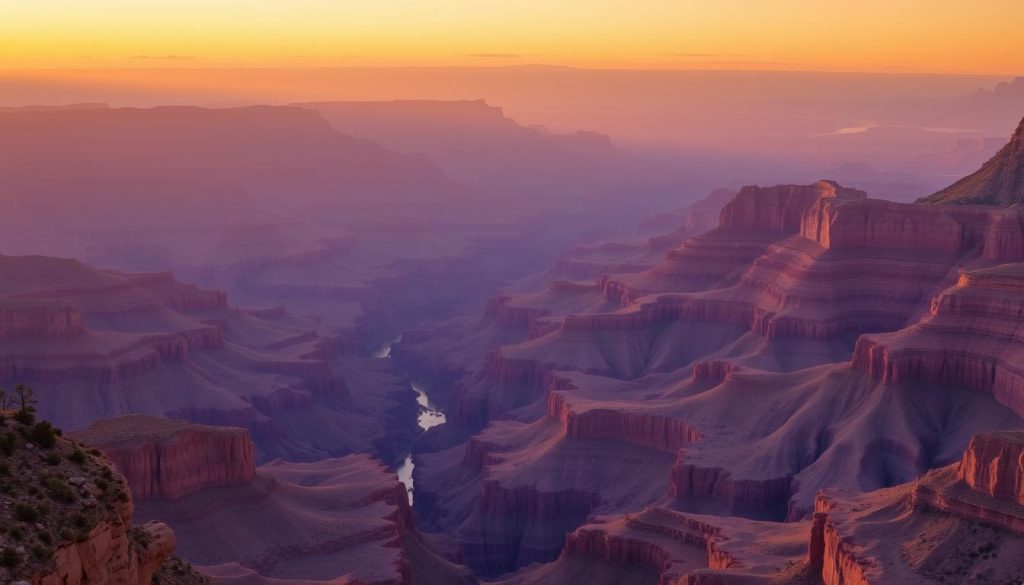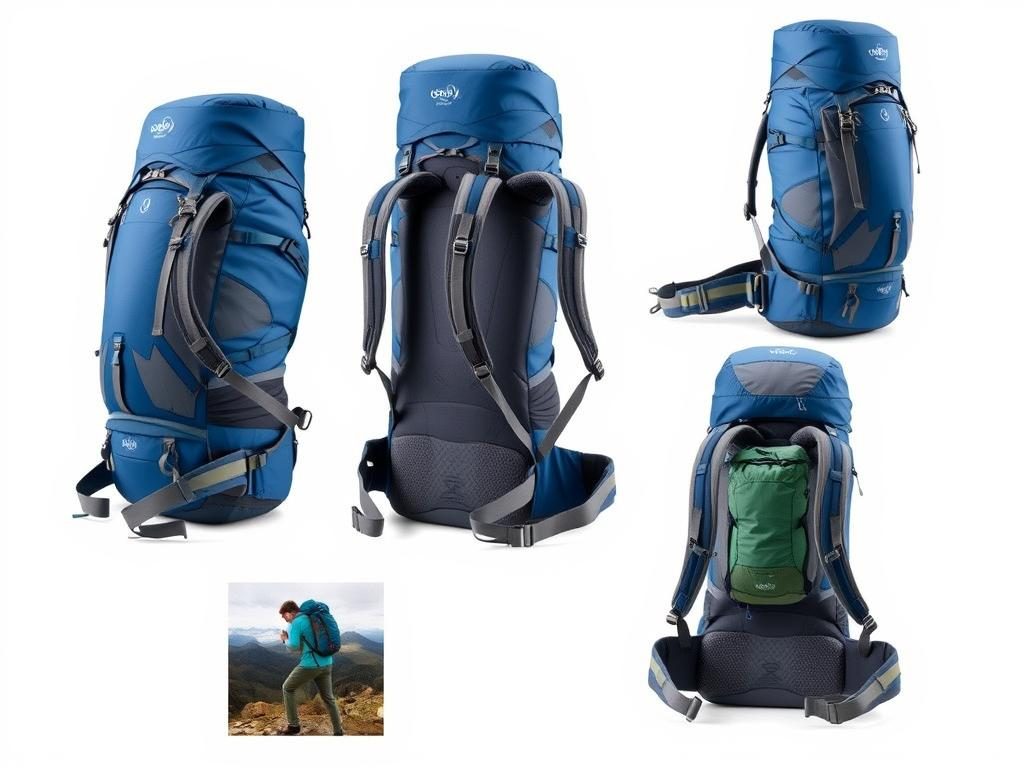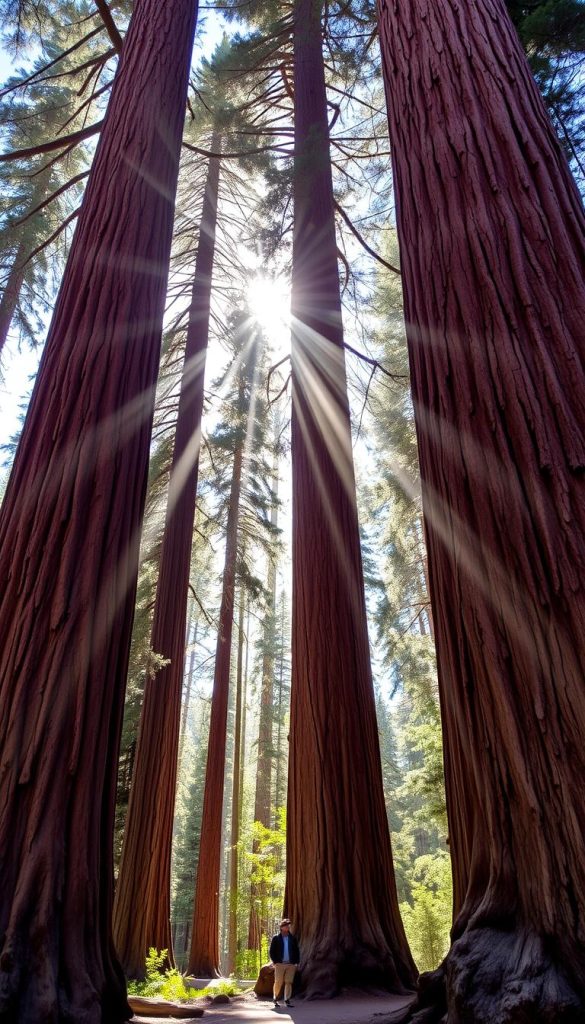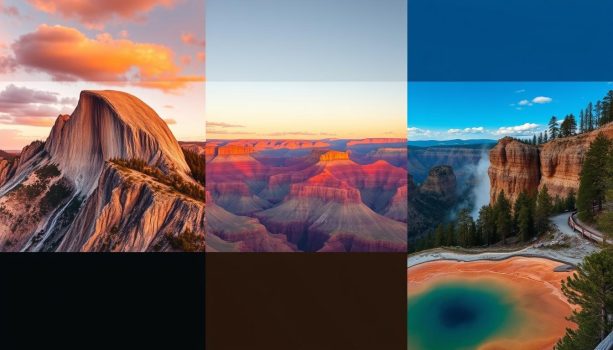From towering granite cliffs to ancient sequoias, America’s national parks are amazing. They have vibrant geothermal features and breathtaking canyons. These parks let you connect with nature in many ways.
You can hike through pristine wilderness or photograph wildlife. Or, you can just enjoy the views that go on forever.
There are over 63 national parks in the United States. Choosing which to visit can be hard. That’s why we made this guide to America’s most stunning national parks. It has must-see attractions, trail recommendations, and the best times to visit.
We also suggest essential gear for your adventures. This way, your trips will be comfortable, safe, and unforgettable.
1. Yosemite National Park, California

Yosemite National Park is a wonder of nature. It has huge granite cliffs, waterfalls, and old sequoias. Millions visit each year to see its beauty.
Must-See Attractions
- Yosemite Valley – The heart of the park featuring El Capitan, Half Dome, and breathtaking valley views
- Yosemite Falls – North America’s tallest waterfall at 2,425 feet, most impressive during spring snowmelt
- Mariposa Grove – Home to over 500 mature giant sequoias, including the famous Grizzly Giant and California Tunnel Tree
Best Hiking Trails
- Mist Trail to Vernal and Nevada Falls (Moderate to Strenuous, 7 miles round trip) – Experience the refreshing mist as you climb alongside these powerful waterfalls
- Sentinel Dome and Taft Point Loop (Moderate, 5 miles) – Offers some of the most spectacular views in the park with relatively modest effort
- Mirror Lake Loop (Easy, 2-5 miles) – Perfect for families, featuring stunning reflections of Half Dome in the lake’s calm waters
Ideal Visiting Seasons
Late spring (May-June) is best for waterfalls. Fall (September-October) has nice weather and fewer people. Summer (July-August) is busy but all areas are open. Winter is quiet but some areas close.
Go to popular spots early or late to avoid crowds. Staying in the park lets you explore more in the morning and evening.
2. Grand Canyon National Park, Arizona

The Grand Canyon is huge and colorful. It was made by the Colorado River over millions of years. Visitors feel amazed by its size and the layers of rock.
Must-See Attractions
- South Rim Viewpoints – Mather Point, Yavapai Point, and Desert View offer classic views of the canyon
- North Rim – Less crowded with unique views from Bright Angel Point and Cape Royal
- Colorado River – See the canyon from below by rafting or hiking to the river
Best Hiking Trails
- Bright Angel Trail (Moderate to Strenuous, variable distance) – A well-maintained trail with shade, water, and great views
- South Kaibab Trail (Strenuous, variable distance) – Direct to the river with wide views
- Rim Trail (Easy, up to 13 miles) – Flat, paved trail along the South Rim with many viewpoints
Ideal Visiting Seasons
Spring (April-May) and fall (September-October) are great for hiking. Summer is hot and crowded. Winter is quiet and snowy.
The South Rim is open all year. But the North Rim is only open from mid-May to mid-October. Always carry water and remember going up is harder than going down.
3. Yellowstone National Park, Wyoming, Montana & Idaho

Yellowstone is America’s first national park. It has amazing geysers, wildlife, and landscapes. You can see geysers, mud pots, and hot springs that look like they’re from another world.
Must-See Attractions
- Old Faithful and Upper Geyser Basin – Home to the famous predictable geyser and the largest concentration of geysers in the world
- Grand Prismatic Spring – The park’s largest hot spring, renowned for its stunning rainbow of colors
- Grand Canyon of the Yellowstone – Dramatic canyon with two magnificent waterfalls and colorful rock walls
Best Hiking Trails
- Fairy Falls Trail (Moderate, 5 miles round trip) – Leads to a 200-foot waterfall with an optional detour to an overlook of Grand Prismatic Spring
- Mount Washburn (Moderate to Strenuous, 6.4 miles round trip) – Offers panoramic views of the park from a 10,243-foot summit
- Mystic Falls Loop (Moderate, 3.5 miles) – Features a beautiful waterfall and views of the Biscuit Basin geothermal area
Ideal Visiting Seasons
Summer is busy but all roads are open. Spring and fall are less crowded. Winter is snowy and quiet.
Visit in May or September for fewer people. Early morning and evening are best for seeing wildlife.
Gear Up for Rocky Mountain Adventures

Osprey Atmos AG 65 Backpack
Yellowstone and Grand Canyon trails need a good backpack. The Osprey Atmos AG 65 makes heavy loads feel light. It’s great for long hikes.
This backpack keeps you cool in the desert. It has lots of space for water, snacks, and camera gear. You can easily find what you need for photos.
- Anti-Gravity suspension distributes weight evenly for all-day comfort
- Integrated rain cover protects gear during unexpected weather changes
- Adjustable harness and hip belt for customized fit across varied terrain
4. Rocky Mountain National Park, Colorado

Rocky Mountain National Park is amazing. It has over 60 peaks over 12,000 feet. You can see mountains, lakes, and wildlife in different places.
Must-See Attractions
- Trail Ridge Road – America’s highest paved road, with amazing views and wildlife
- Bear Lake – A scenic spot for beautiful trails and mountain views
- Moraine Park – A big valley for great wildlife watching, like elk in the fall
Best Hiking Trails
- Emerald Lake Trail (Moderate, 3.5 miles round trip) – Sees three alpine lakes with stunning mountains
- Sky Pond via Glacier Gorge (Strenuous, 9 miles round trip) – Has waterfalls, lakes, and mountain views
- Alpine Ridge Trail (Easy, 0.6 miles round trip) – Short but offers views from 12,000 feet
Ideal Visiting Seasons
Summer (July-August) is best for hiking with wildflowers and access to all areas. Fall (September-early October) has great foliage and elk bugling. Winter is for snowshoeing and skiing, and spring has waterfalls from snowmelt.
The park has a timed entry system in peak months. Arrive early or late to avoid crowds and reservations. The free shuttle helps with parking at popular spots.
5. Zion National Park, Utah

Zion’s sandstone cliffs are in cream, pink, and red, rising high above the canyon floor. The Virgin River has made a home of hanging gardens, emerald pools, and wildlife. It’s a place of wonder and exploration.
Must-See Attractions
- Zion Canyon – The park’s heart, seen by shuttle bus with stops at major spots
- The Narrows – A gorge with walls a thousand feet tall and only 20-30 feet apart
- Emerald Pools – Desert oases with clear pools and small waterfalls in red rock
Best Hiking Trails
- Angels Landing (Strenuous, 5.4 miles round trip) – Has stunning views from a 1,488-foot rock (permit needed)
- The Narrows (Moderate to Strenuous, variable distance) – Wade through the Virgin River
- Canyon Overlook Trail (Easy to Moderate, 1 mile round trip) – Offers Zion Canyon views with little effort
Ideal Visiting Seasons
Spring (April-May) and fall (September-October) are nice with colors. Summer is hot but good for river activities. Winter is quiet with snow on the rocks.
Zion uses a shuttle system in the main canyon in peak times. Enter early or visit Kolob Canyons to avoid crowds. Always check the weather before hiking The Narrows or other canyons.
6. Glacier National Park, Montana

Glacier National Park is the “Crown of the Continent.” It has rugged mountains, alpine meadows, turquoise lakes, and glaciers. It’s a home for grizzly bears and mountain goats, with amazing mountain views.
Must-See Attractions
- Going-to-the-Sun Road – An engineering marvel cutting through the heart of the park with breathtaking vistas at every turn
- Many Glacier – Often called the park’s “alpine heart,” featuring stunning lakes, abundant wildlife, and dramatic peaks
- Lake McDonald – The park’s largest lake, known for its crystal-clear waters and colorful stones
Best Hiking Trails
- Highline Trail (Moderate to Strenuous, 11.8 miles one way) – A spectacular ridge-line trail with constant panoramic views
- Grinnell Glacier (Strenuous, 7.6 miles round trip) – Leads to one of the park’s most accessible glaciers with stunning turquoise lakes along the way
- Hidden Lake Overlook (Moderate, 2.7 miles round trip) – Offers magnificent views of Hidden Lake and surrounding peaks from Logan Pass
Ideal Visiting Seasons
Mid-June through mid-September is the best time to visit. Going-to-the-Sun Road is fully open from late June to mid-September. July and August have the best weather and access to trails, but it’s busier.
Early fall is beautiful with fewer visitors. But, services start to close. Glacier requires vehicle reservations for Going-to-the-Sun Road and North Fork during peak season. Arrive early or late to park at popular spots. Always carry bear spray and know how to use it.
Essential Shelter for National Park Camping

REI Co-op Half Dome 2 Tent
After exploring Glacier’s meadows or Zion’s canyons, you’ll need a good shelter. The REI Co-op Half Dome 2 Tent is perfect for camping in national parks. It’s comfortable, durable, and easy to set up.
This tent has near-vertical walls for more space. Its color-coded pole system makes setup simple. It has two doors and vestibules for easy access and storage. Mesh panels keep you cool on warm nights.
- Spacious interior comfortably fits two people with gear
- Durable construction withstands variable mountain weather conditions
- Excellent ventilation prevents condensation in humid environments
7. Grand Teton National Park, Wyoming

Grand Teton National Park has stunning mountain scenery. The Teton Range rises sharply from the valley. It’s a photographer’s dream and an outdoor enthusiast’s paradise.
Must-See Attractions
- Grand Teton – The park’s namesake peak rising 13,775 feet, flanked by other impressive summits in the Teton Range
- Jenny Lake – A stunning glacial lake at the base of the Tetons with spectacular mountain reflections
- Mormon Row Historic District – Historic homesteads featuring the iconic Moulton Barns against the Teton backdrop
Best Hiking Trails
- Cascade Canyon (Moderate, 9 miles round trip) – Offers spectacular views after a boat ride across Jenny Lake and hike to Inspiration Point
- Delta Lake (Strenuous, 7 miles round trip) – Rewards hikers with a stunning turquoise alpine lake beneath the Grand Teton
- Taggart Lake Loop (Easy to Moderate, 3.8 miles) – Accessible trail with beautiful lake and mountain views
Ideal Visiting Seasons
Summer (June-August) is great for hiking and water fun, but it’s busy. Fall (September-October) is beautiful with colors and fewer people. Winter is quiet for skiing and snowshoeing. Spring is full of wildflowers and new animals.
For amazing photos, go early morning or evening. The Tetons look best then. For seeing animals, go at dawn or dusk in places like Willow Flats. Always keep a safe distance from animals, like bears and bison.
8. Olympic National Park, Washington

Olympic National Park is huge, with mountains, rainforests, and coastline. It’s a UNESCO World Heritage Site. It has a complete ecosystem in a small area.
Must-See Attractions
- Hoh Rain Forest – A top temperate rainforest in the U.S., with lots of rain
- Hurricane Ridge – Has great views of mountains, strait, and Vancouver Island
- Ruby Beach – Has sea stacks, tide pools, and driftwood
Best Hiking Trails
- Hall of Mosses Trail (Easy, 0.8 miles) – Shows mossy trees in the Hoh Rain Forest
- Hurricane Hill (Moderate, 3.2 miles round trip) – Offers views of mountains, strait, and Vancouver Island
- Marymere Falls Trail (Easy, 1.8 miles round trip) – Takes you to a 90-foot waterfall
Ideal Visiting Seasons
Summer (July-August) is the best for weather and access. Spring is green and colorful. Fall has fewer people and beautiful colors. Winter is quiet but cold.
The weather changes a lot in Olympic. Always wear layers and rain gear. The park is big, so plan extra time to get around.
9. Arches National Park, Utah

Arches National Park has over 2,000 stone arches. It’s a red-rock wonderland with arches, pinnacles, and fins. It’s like a dream with its beauty and delicate formations.
Must-See Attractions
- Delicate Arch – The park’s most famous arch, a 65-foot freestanding arch
- Landscape Arch – The world’s longest natural stone arch, 306 feet long
- Windows Section – Has many large arches, easy to get to
Best Hiking Trails
- Delicate Arch Trail (Moderate, 3 miles round trip) – Takes you to the famous arch, best at sunset
- Devils Garden Loop (Moderate to Strenuous, 7.8 miles) – Has eight impressive arches, including Landscape Arch
- Park Avenue Trail (Easy, 2 miles round trip) – Walks through tall rock walls
Ideal Visiting Seasons
Spring (April-May) and fall (September-October) are great for hiking. The weather is nice and not too hot. Summer is very hot, with temperatures over 100°F. It’s best to go out early in the morning or late in the evening.
Winter is special, with snow making the red rocks stand out against blue skies.
Arches needs timed entry from April to October. Go early in the morning or late in the evening for the best photos. There’s little shade, so bring lots of water and sun protection. Plan your hikes when it’s cooler in summer.
10. Sequoia National Park, California

Sequoia National Park is home to the world’s biggest trees, like the General Sherman Tree. It’s the biggest living thing on Earth. The park also has vast wilderness, mountains, canyons, and lots of wildlife.
It has both small forest groves and big alpine views. This makes it a special place to visit.
Must-See Attractions
- General Sherman Tree – The world’s largest tree by volume, estimated to be over 2,200 years old
- Giant Forest – Home to five of the ten largest trees in the world, with several easy walking trails
- Moro Rock – A granite dome with views of the Great Western Divide and western half of the park
Best Hiking Trails
- Congress Trail (Easy, 2 miles) – A paved loop through the Giant Forest with many big sequoias
- Tokopah Falls Trail (Moderate, 3.4 miles round trip) – Follows the Marble Fork of the Kaweah River to a 1,200-foot cascading waterfall
- Alta Peak Trail (Strenuous, 13.7 miles round trip) – Climbs to 11,204 feet with spectacular views of the Great Western Divide
Ideal Visiting Seasons
Summer and early fall are the best times to visit. Spring has waterfalls and wildflowers. Winter is magical, but roads may close and you might need chains or 4WD.
The park uses shuttles in summer to reduce traffic. Visit early morning for the best sequoia views. The park’s elevation changes, so be ready for different temperatures.
Footwear for Every National Park Trail

Salomon Quest 4 Gore-Tex Hiking Boots
Good shoes are key for hiking in Sequoia, Grand Canyon, and Zion. The Salomon Quest 4 Gore-Tex Hiking Boots are versatile and protective.
They keep your feet dry in Yellowstone and Olympic’s rain. They’re also breathable for desert hikes in Arches. The boots are stable on rocky trails and have good grip on mud and slickrock.
- Waterproof protection for stream crossings and unexpected weather
- Excellent ankle support for carrying loaded backpacks on varied terrain
- Durable construction stands up to hundreds of trail miles
Embrace the Wonder of America’s National Parks

America’s national parks are full of natural wonders. They offer experiences you can’t find anywhere else. From giant sequoias to the Grand Canyon, these places connect us to nature.
Every visit to a national park is special. You’ll see new things and feel the changing seasons. With the right planning and gear, you can explore safely and help protect these places for the future.
Remember, these parks are loved for a reason. Plan ahead, arrive early, and follow Leave No Trace. The memories you make will inspire you to care for nature and explore more.





